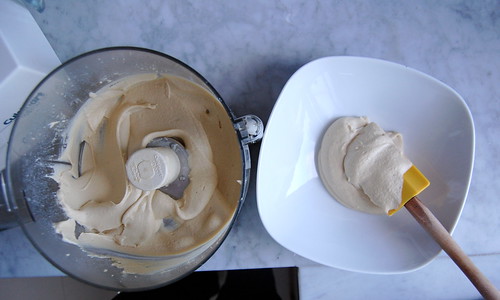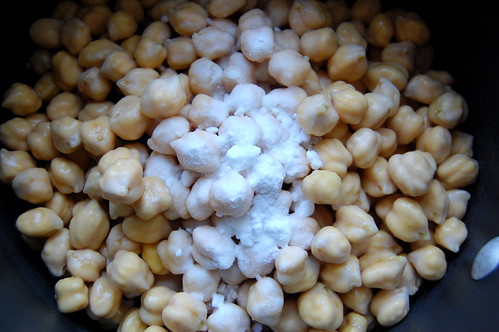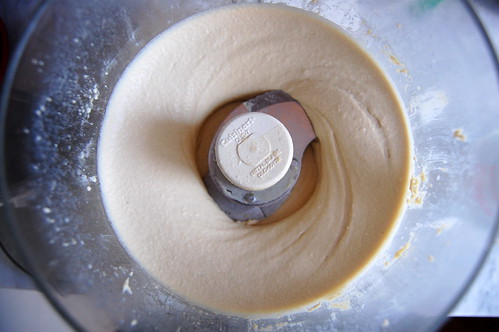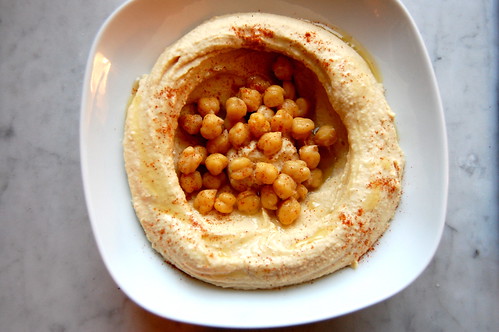
Oh yes. It's time to talk hummus. Again. It's September -- time for back to school, new jobs, more traffic, and half your office is no longer on vacation. And it's time to get serious, with hummus. For long time readers, you know I was pretty serious about hummus when I first posted about it here over five years ago. But I think it's time we talked about it again.
Some of the things I talked about many years ago have not changed - I still think you have to peel the chickpeas, I will still have a coniption if you call something with white beans "hummus." But a lot of things about my method have changed, and I'll explain why.

First of all, I have made hummus over a dozen times in the last two months. Luckily, you already knew I was a crazy person. When Paul sees another bowl of chickpeas soaking on the counter he now groans with dread. But all that cooking, testing this method vs that, soaking chickpeas, peeling them, not peeling them, all led me to a new and improved recipe.

So what's changed? Well, you still have to cook your chickpeas from scratch to make good hummus, that has not changed. And yes, you still have to peel the chickpeas. But what has changed is baking soda. Yes, baking soda.
You see, a while back, I was eating at a Lebanese restaurant and noticed how soft, tender, and deeply yellow their chickpeas were. And I started thinking how a better technique for cooking chickpeas could lead to better hummus. Baking soda is a well-documented way to make chickpeas soft, tender, and yellow in color. So why didn't I use baking soda before? Well, before my recipe called for using some of the chickpea cooking water to thin the hummus, but chickpea cooking water with baking soda has an off taste. So, I've swapped that out with some cold water. I've also updated my recipe a bit to incorporate my own laziness, doing the whole thing in the food processor, instead of making the tahini sauce separately.
So go forth my friends, make some hummus!
P.S. Notice how the hummus in the top photo looks smoother than the hummus in the bottom photo? Well, the bottom photo is form one of my experiments with unpeeled chickpeas. The difference in visible folks!

Hummus bi-Tahini
The quality of your tahini makes a difference here, so try to find the best quality and freshest tahini (sesame seed paste) available. Baking soda does not interact well with pots with non-stick linings, so avoid using them here. This recipe makes more chickpeas than you may need.
2 cups dried chickpeas
1 teaspoon baking soda
1 very small clove of garlic
1/2 teaspoon salt (preferably sea salt or other good quality salt)
juice of 1 small lemon
scant 1/2 cup tahini paste (6-7 tablespoons)
for serving: olive oil, cayenne and/or cumin
1. Soak the chickpeas in plenty of water overnight, or for as long as 24 hours.
2. Drain and rinse the chickpeas. Add the chickpeas to a large pot, preferably a heavy-bottomed clay or ceramic pot, add the baking soda, and plenty of water to cover. Bring the pot to a boil, watching it closely because the baking soda may cause it to foam and overflow. When the water boils, lower the heat so that your chickpeas are just at a simmer. Skim off the baking soda foam.
3. Simmer the chickpeas until they are golden, the skins are loosened, and they are tender when squished with your finger, but don't totally turn to mush. For me this usually takes 40 minutes, but it could take up to 50-70 minutes.
4. Drain the chickpeas and give them a quick rinse with cool water. Now peel your chickpeas by simply pinching the skins off them. Transfer the peeled chickpeas to a bowl and discard the skins. You can choose to refrigerate of freeze your chickpeas here, or proceed immediately.
6. Measure out two lightly-packed cups of chickpeas into your food processor, reserving the rest for later. Add in the garlic and salt and run the food processor to create a coarse paste.
7. Add in the tahini and lemon juice. Turn on the food processor and process for 2-3 minutes, letting the mixture come together. Check how thick your hummus is, and taste for seasoning. You may want more salt. With your food processor running, add 2-4 tablespoons of very cold water, depending how thick/thin you want your hummus. Remember that your hummus will thicken as it cools so I tend to err on the side of a little looser mixture. Run your food processor for 2-3 more minutes so that the hummus is very smooth. Check for seasoning, it may need more salt.
9. Scoop your hummus into a serving container and let rest for 10-15 minutes for the flavors to meld. Place some of the reserved cooked chickpeas over your hummus. Drizzle olive oil over the top and sprinkle with cayenne and/or cumin as desired.
Ideas for hummus variations here.
Tips:
1. If you plan to serve your hummus the next day, you can store it covered in the food processor bowl. That way, if it gets too thick, you can easily whiz it with a touch of water.
2. If you make your hummus too thin, you can add in some of your extra reserved chickpeas.
3. If you only have a blender (not recommended, but sometimes your only option), place the lemon juice in the bottom of your blender before the chickpeas. This will help the blender get going.






1 comment:
Mouthwatering! :)
Post a Comment